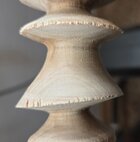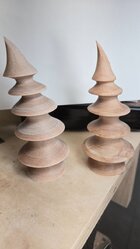This is one of those things that makes me want to get in the car and come visit! Maybe get one of the club members to look at your tools and technique, maybe even visit your shop and watch. There are so many "little" things to consider.
I'll talk with the guys at the meeting about the chip out and "float the bevel"
I think the terms "float the bevel" and other variations all describe the same thing: the clearance angle. The sharp edge cuts into the wood at an angle and the angle and depth of the cut are what provide that very tiny but absolutely necessary support to the edge - it's a delicate balance between too little and too much. Sometimes the term "riding the bevel" or something similar is used, but fact is if the bevel is riding nicely against the wood the edge is not cutting. There needs to be a tiny clearance angle for the cut to happen - I'm sure that's what people mean by "riding" but occasionally someone doesn't quite understand what's going on. The C in the ABCs of turning (Anchor, Bevel, Cut) depends on the clearance angle.
I think Mike Darlow explains this best in his book "Fundamentals of Woodturning". Some say his books are too "technical" but I read every word then started over and read it all again and again. He has some wonderful diagrams and incredible photos illustrating the principles. I stole, er, borrowed just one photo from the book, this one showing a peeling cut - about as simple as it gets. The photo shows well the clearance angle needed for a perfect cut for that tool grind. Other photos in hte book show exactly what happens with the clearance angle is too small or too large. (Zero degrees, 2-deg, 12-deg, and 23-degrees.)
The photo is of a peeling cut with a skew ground straight across but the principle is the same for all cutting tools, even the complex curves of spindle or bowl gouge. The geometry for scraping is different, but also covered.

[Figure 4.2 from Mike Darlow's "Fundamentals of Woodturning]
His diagrams explain the angles in far more detail and include things like the supporting force, severance force, shaving force, toolrest force, shaving friction, elastic recovery, plastic deformation and far more. Someone with a bit of physics background may get more out of it than some others. The biggest practical thing is the clearance angle.
But anyone who reads can't help but learning a LOT from Darlow, and for me, all of it helped. He starts with spindle turning as do many of the better teachers, but covers boxes, bowls, hollow forms and more. I can't begin to get across how valuable this book was to me.
I like his philosophy too, evident in the statement "...resist short-cutting to the ... glamour of the so-called advanced techniques", followed by a short list of the seriously counterproductive problems this can cause. We are all tempted, but at what cost... If I were king that one section alone would be required reading for every woodturner!
He has a series of exercises using various tools - even a rank beginner who does all those will morph into an expert turner, ready to teach others. I think Darlow's instruction and illustrations on cutting coves with a gouge are worth the cost of the book! (If you have or get the book check out Figure 6.77)
I basically learned woodturning from that book and "Turning Wood" by Richard Raffan. I keep multiple copies of both books, sometimes find them used, and loan them to students who show that certain "spark."
(Sorry, I'm a certified book freak. I think my little shop library has every book both authors wrote plus dozens from other authors. I also learned a lot from Keith Rowley's book "Woodturning: A Foundation Course". Rowley and others point out that if you learn spindle turning first, it will teach the fine tool control that will let you turn anything, including big bowls. He states the converse is not necessarily true. One more book I recommend to everyone is "Understanding Wood: A Craftsman Guide to Wood Technology" by R. Bruce Hoadley, another one I keep several copies of.)
JKJ




